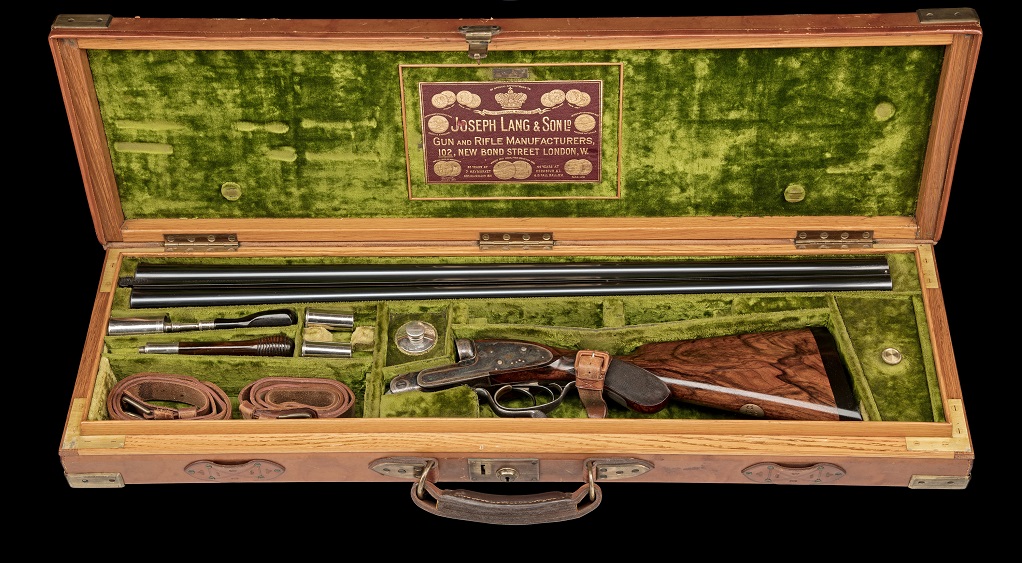I well remember in my teaching career when the National Lottery was introduced.
Every single pupil in the class, when asked to write an essay, would choose the question of what they would buy if they won the lottery. It was so boring as they all said the same, house, holiday, car…. zzz.
Wel,l just for a change, I thought you might like the same though,t but this time regarding unattainable lots in the last six Holts sales – guns that you can only dream about that fetched high prices.
In last year’s March sale there was a flintlock seven-barrelled volley rifle c1800 by Henry Nock, London as lot 405. It was a goose rifle and all seven barrels discharged simultaneously at a flock of geese before they rose in the air. Such rifles were difficult to make setting all seven barrels together and consequently they were expensive. Nothing much has changed today. This lot estimated at £14,000 – £16,000 made an astonishing £20,000.
Double rifles by well known makers always fetch high prices and if they are big game rifles then that only adds to their value. In this same sale lot 1250 was a Holland & Holland Royal .577 sidelock ejector double rifle built in 1900. As you would expect it was of fabulous quality but in addition was in excellent original condition.
To make it even more fascinating was a note in the Holland archives stating that it was sold to ‘Burrard’ in 1916. This was Major Gerald Burrard who penned the classic gun book The Modern Shotgun in 1931/2. He served on the Somme at this time and it was most likely that he bought this massive calibre rifle to use against armour plated German snipers. He certainly wasn’t going big game hunting in 1916!
Estimated at £30,000 – £40,000 it made its lower estimate of £30,000.
Pairs of Purdeys always fetch good prices and particularly so if they are in good original condition. Lot 1270 saw a pair of 20 bore Purdey sidelock ejectors built in 1955 retaining most of their original finish with little signs of use.
Being 20 bore made them more desirable too. Contained in their original motor case they were estimated at £35,000 – £40,000 and made the high end at £40,000. Considering their paucity of use they were a bargain as a similar pair today would cost well over £200,000.
In the December 2017 sale there was a very rare double .450 round action rifle by James MacNaughton of Edinburgh with his classic skeleton action. MacNaughton introduced the famous Edinburgh round action in 1879 that was quickly copied by Dickson in 1880.

However, unlike Dickson, MacNaughton favoured skeleton actions or bar-in-wood actions whereby the woodwork completely encased the action to give a very elegant look. Compared to Dickson he did not build many round actions and as for his round action rifles, well they are the proverbial hens teeth. This rifle built around 1882 was ordered by F.J. Usher of the famous brewing family and estimated at £8000 – £12,000 it soared to £16,000 reflecting its desirability.
Very few of us have the need these days for a pair of guns but how about a trio? Lot 1350 included a fabulous trio of 12 bore round bodied over and under guns by Watson Bros. of London that were essentially brand new completed in 2016. Each gun in addition had two sets of barrels 32” and 29” long. They were magnificently engraved by Erich Friedrich and estimated at £140,000 – £180,000 they made £150,000.
In the September 2017 sale lot 510 illustrated yet again the importance of condition to value. This lot was a cased 14 bore percussion gun built in 1853 by John Dickson & Son of Edinburgh. Being a Dickson it was of best quality but in addition it was in very original condition with much case hardening and very little sign of use. Many buyers thought the same and estimated at £2000 – £3000 it made an impressive £5100.
Want something to really impress your friends as the ultimate high pheasant gun? How about lot 920, a pair of best quality sidelock 8 bores by Joseph Lang of London each gun weighing a hefty 12lbs. 15oz. They were built in 1911 and shipped to America for wildfowling.
Contained in two separate green velvet lined cases they both looked like they had never been fired and were top quality for a pair of big bores. On the stand at the Game Fair in the summer of that year they were the star attraction. Price? Estimated at £40,000 – £50,000 they made £45,000.
TAGS

